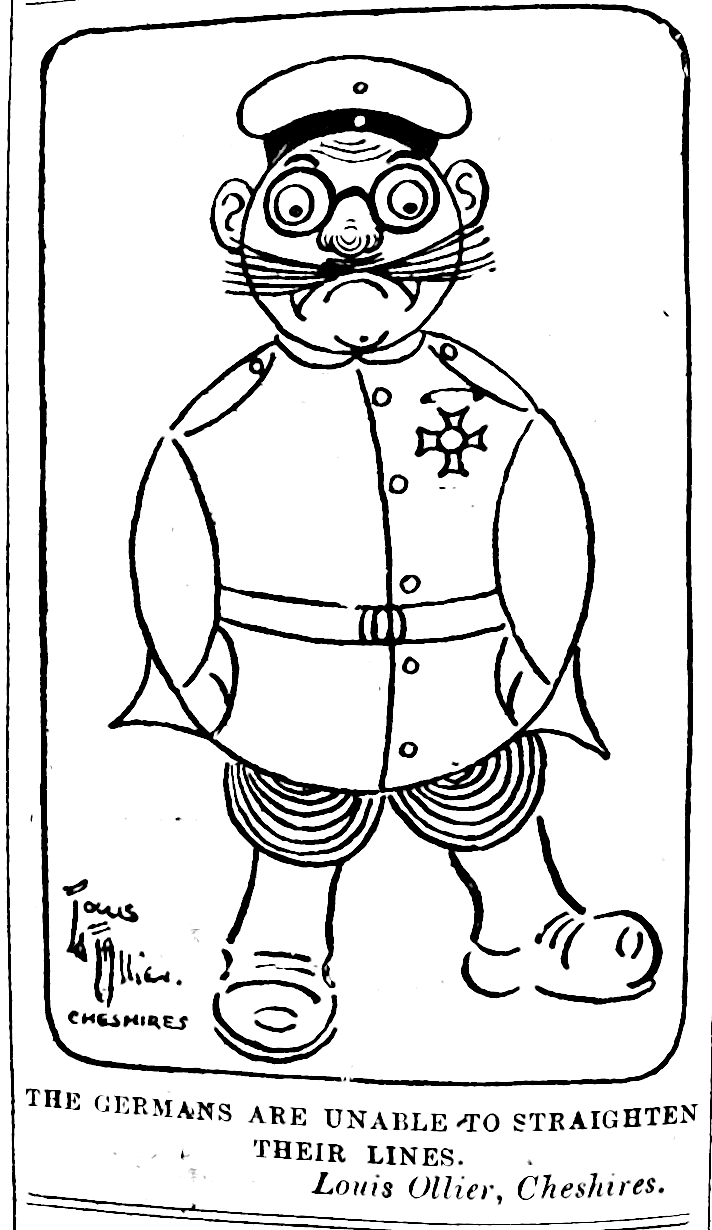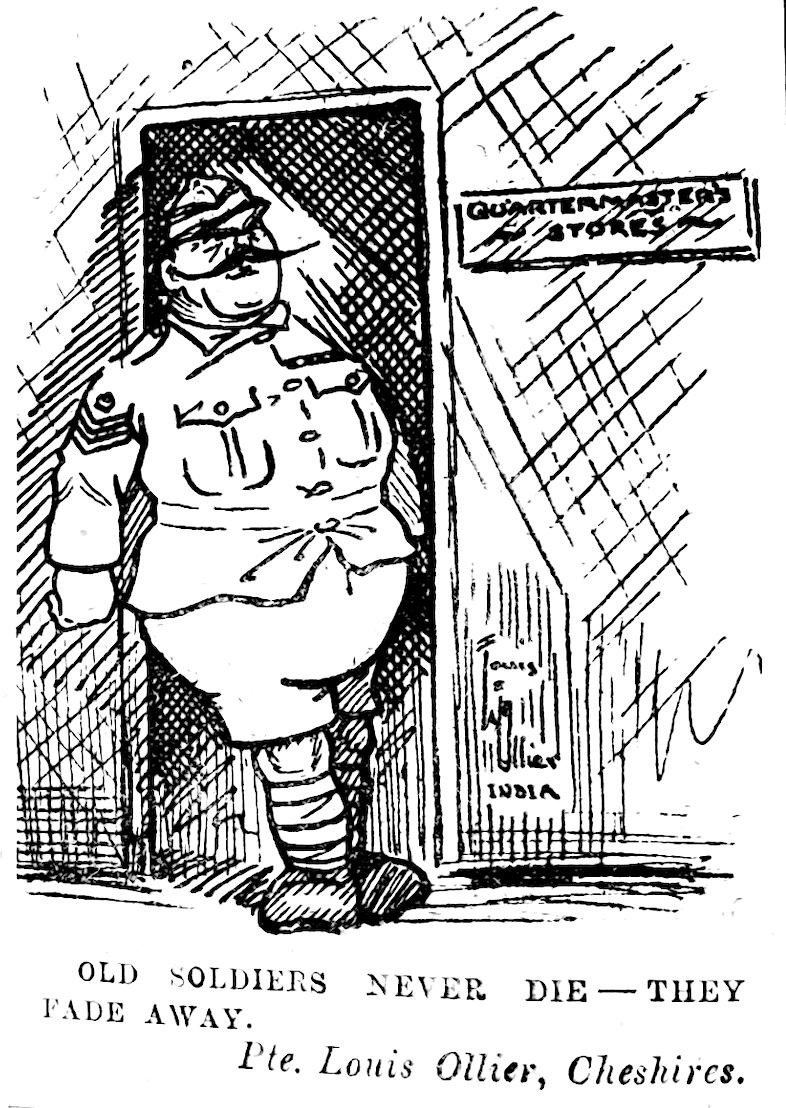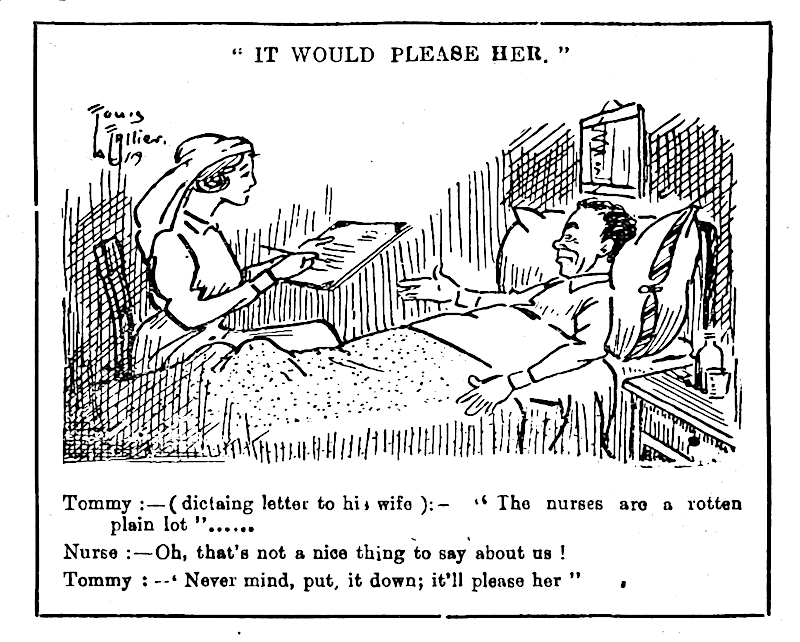Soldier-cartoonist: Private Louis Ollier, 8th Cheshire Regiment
Private Louis William Ollier, 8th (Service) Battalion Cheshire Regiment (later 12th Combined Depot)
Service Number: 59312
Born: 7 March 1898, Crewe, Cheshire.
Died: 16 May 1979, Waterloo, Liverpool (aged 81)
Ollier was born in 1898 in Crewe, Cheshire, the son of Richard Ollier, a Railway Clerk, and Nellie.1 He attended Hightown Boy's School from the age of 3, where he showed an entrepreneurial flair, creating a playground game consisting of a cardboard box with a number of holes cut into the side which he invited his school chums, at a cost of a metal button, to roll a marble through. If the ball made it all the way to the other side, they were rewarded with two buttons. However, the holes were cut only just big enough for a marble to fit, so Louis often ended up in profit.2 After leaving school, he followed in his father's footsteps and joined the railways as a junior clerk in 1912, though he spent much of his free time sketching, which led to a free scholarship at the Crewe School of Art for the 1915-16 session.3
In May 1916, he enlisted in the 8th (Service) Battalion Cheshire Regiment.4 Unfortunately, his service record is lost, but at some point he was assigned to the 12 Combined Depot, stationed in Kirkee (modern day Khadki), India where he remained until being demobbed on 23 October 1919. Exactly when he was posted to India is unknown, but from the surviving records of other men of the regiment, such as Simon Simlo (Service Number 60338) who attested in December 1915, records show that he was posted at home from February 1916, then transferred to 12 Combined Depot in April 1917.5 In support of Ollier having a similar experience (home service followed by overseas), in March 1917, Ollier submitted the following cartoon to Blighty.

In his written signature, he has signed off with 'Cheshires'; in a later cartoon, from December 1918, he signs off with 'INDIA' (Figure 2).

Figure 2 uses perhaps one of the oldest jokes in the British Army, but Figure 1 is of note because, in terms of soldier cartoons — and cartoons in general of the period for that matter — it is unusual that it relies on visual humour. As I have written elsewhere, the art of show and not tell was clearly a work in progress at the time, as cartoons tended to be extremely wordy. Soldiers' cartoons contained an average of 20 words, compared to 4.5 words in modern cartoons.6
While stationed in India, he contributed drawings to the Khaki Opinion: An Illustrated Magazine for All in Khaki including the following (see Figure 3) from September 1919. I suspect this may very well be a self-portrait, similar to the cartoon done by Robert Birrell as, from his pension record, he received a conditional disability payment of 24 shillings per week for a year after his discharge — for Appendectomy, Laporatory and Valvular disease of the heart.7

After the war, Ollier married Ethel Francis in 1921, and they had one daughter, Nora Ollier, in 1922. He went back to his old Railway job before a brief stint at an advertising agency, producing posters and cinema slides for theatres in Nottingham and Sheffield until the agency closed down, and he ended up back, once more, on the railways — working at the Motive Power Department in Crewe — where he remained until retirement in 1958. He continued producing cartoons during this period, including for the railway staff magazine Carry On, and became the sports cartoonists for the Crewe Chronicle between 1949 and 1960.8
As a hobby, Ollier produced sketches of famous people, which he would send to them, with a stamped addressed envelope, asking for a signature. Over the course of his lifetime, he amassed a collection of over 400 signed sketches in this manner, from a wide range of prominent individuals, such as Charlie Chaplin, Winston Churchill, and Mahatma Ghandi.9
With thanks to Bairnsfather Historian Mark Warby for identifying Ollier, and providing the article on him from the Jester. And to Stephen Benson, custodian of the Cheshire Rolls for clarifying a few things about the Cheshire Regiment.
-
1901 Census England and Wales. ↩︎
-
Nantwich School, 4 February 19161, p.15. ↩︎
-
Mark Warby, 'Crewe's Cartooning Railwaymen', The Jester: The Monthly Magazine of the Cartoonist's Club of Great Britain, February 2022, p.24. ↩︎
-
Cheshire Regiment, Roll of Individuals of the War Badge ↩︎
-
https://www.greatwarforum.org/topic/306326-any-info-on-59312-private-lewis-william-ollier-cheshire-regiment-please/, retrieved 28 November 2023. ↩︎
-
Robert St. John Smith, 'Budding Bairnsfathers, Blighty Magazine and Cheery Tommy Atkins', Stand-To!, 131 (2023). ↩︎
-
WW1 Pension Ledgers and Index Cards, 1914-1923, Form SB.36. ↩︎
-
M. Warby, 'Crewe's Cartooning Railwaymen', p.26. ↩︎
-
Crosby Herald, 6 June 1991, p.27. ↩︎
Posts in this series
- Soldier-cartoonist: Corporal Harry Cotton, Meteorological Office, 4th Army HQ
- Soldier-cartoonist: Sapper Charles Albert Kennett, Royal Engineers
- Soldier-cartoonist: Private Louis Ollier, 8th Cheshire Regiment
- Soldier-cartoonist: Private Alfred Edmeades Bestall, Army Service Corps
- Blighty Mystery File No.1
- Soldier-cartoonist: Corporal Bertie Inward, 2/19th London Regiment
- Soldier-cartoonist: Private Richard Collins, 12th Battalion East Surrey
- Solider-cartoonist: Corporal Gontran De Tournoüer, 11th Field Artillery Brigade, Australian Imperial Force.
- Soldier-cartoonist: Lance Corporal Gilbert Tom Webster 26th Royal Fusiliers
- Soldier-cartoonist: Private Charles "Chas" William Holt, 16th Sherwood Foresters [Unconfirmed]
- Soldier-cartoonist: Corporal Robert Birrell, 17th Highland Light Infantry
- The ‘Budding Bairnsfathers’ : First World War Soldier-cartoonists Published in Blighty